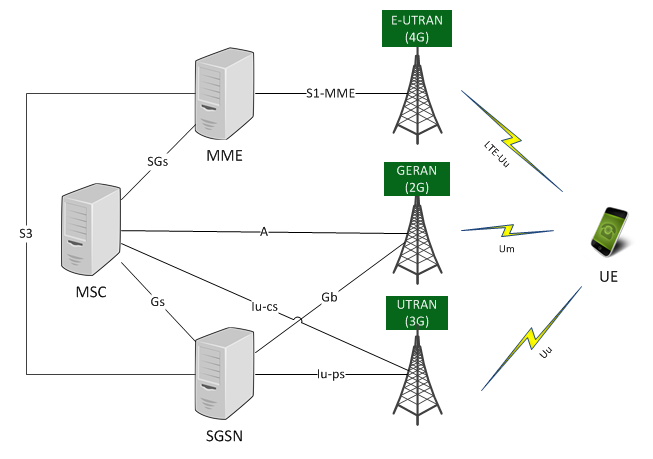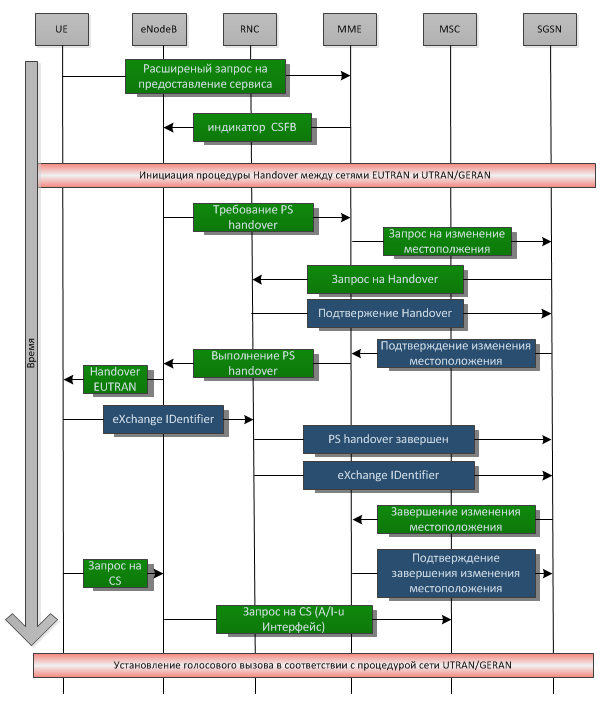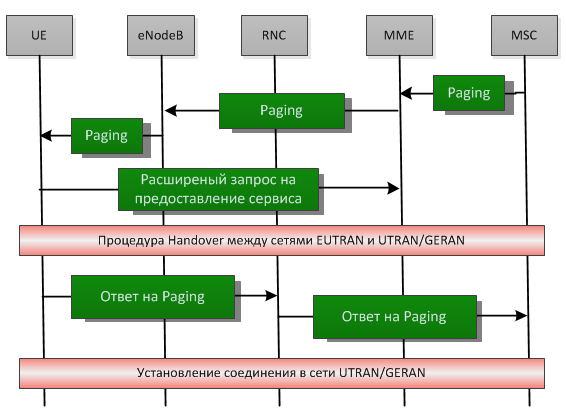The first step towards voice in LTE - Circuit Switch FallBack

In the last article about LTE, we mentioned the CSFB (Circuit Switch FallBack) voice service technology. LTE networks are designed to transmit packet information, there is no voice in this network in the sense in which we understand this using the example of traditional GSM / UMTS networks. But, there is an opportunity to change it.
At the moment, testing and tuning of CSFB technology, which uses the now existing, traditional CS ( Circuit switching) 2G / 3G network domain. This is because the original technology for voice transmission in LTE - VoLTE (Voice over LTE), where voice is already transmitted over an IP network using LTE means without involving previous generation networks, is dependent on so many state-level solutions and permissions. In order to create conditions for making calls using VoLTE, it is necessary to provide support for this functionality not only by the network, but also by user equipment (User Equipment / UE).
We will leave VoLTE for future articles, but for now we will consider CSFB from the technical side.
CSFB - Circuit switch fallback
The simplified EPS network architecture for organizing CS fallback and sending SMS messages is shown in the figure and is based on the use of the SGs interface:

Features / specifications of equipment supporting CS fallback
The UE naturally has access to both the E-UTRAN / EPC and the CS domain via the GERAN and / or UTRAN network.
The MME uses the LAI and the hash value obtained from the IMSI to determine the VLR number, in case multiple LAs are serving the same MSC / VLR, the same hash value / function is used in the SGSN .
With MSC, everything is clear, but it is also possible to expand the CS fallback functionality with ICS and / or SRVCC support.
Mobile Originated Call - Subscriber calls from LTE
What happens when a subscriber who is on an LTE network makes a call? Let's look at a simplified call flow (a diagram of the exchange of signal messages between network elements), which will quite clearly explain everything:

Consider a basic scenario
The lucky owner of an LTE enabled phone is walking along the street in the coverage area of 4G and 3G / 2G networks. In the background, mail, Facebook, Twitter and other services are updated. Deciding to make a call, he performs the usual actions: dials a number andAt this moment, the first extendedrequest (2 years ago it was difficult to imagine that the simplest voice call would be interpreted as an extended request) for the provision of the service. The MME receives the request, having information that the subscriber is in the LTE network, reports the eNodeB so that he initiates the CSFB procedure. The CSFB procedure involves a transfer to a 2G / 3G network, but the phone is already actively using the network at this time: it receives mail and updates from services, and this process cannot be interrupted. eNodeB, seeing an active data transfer, decides to handover to a 3G or 2G network. The decision to select a network is made based on the measurements received from the UE. Thus, the transition between networks occurs without breaking the active data transfer sessions.
The eNodeB reports its decision to the MME, and then the MME is already starting to negotiate with the SGSN. To start this process, you need to make sure that you have the necessary resources for this subscriber in the SGSN (PFCs, PDP context, APN) and in the RNC. To do this, the MME sends an Update Location request to the SGSN. SGSN, in turn, performs the mapping of LTE services (EPS bearer service) to non-LTE services (PDP context) and requests allocation of resources (PFCs - Packet Flow Context) in the RNC. Not all services will be accepted, depending on the load on the 3G network, some EPS services may be discarded.
Then the RNC prepares the so-called “transparent container from source to destination”, which will contain data for both the 3G network (Handover Radio Resources) and LTE (NAS container). After receiving confirmation of the availability of necessary resources, SGSN informs the MME about this, which initiates the Handover procedure (sends a “transparent container” to the eNodeB).
eNodeB, having received the command, begins to "switch" services from MME to SGSN, and at the same time sends a Handover command (with a "transparent container") to the UE. By this command, the UE (smartphone) begins to rebuild on the radio part of the 3G network. For these purposes, the “transparent container” contains data for handover of both LTE and 3G networks. After rebuilding, the UE sends an XID (eXchange IDentifier) message to the new network and at the same time resumes the data transfer. The RNC informs the SGSN about the successful completion of the handover, and also relays the XID to the SGSN. After receiving confirmation of Update Location, the release of MME and eNodeB resources begins.
And then the standard voice call procedure worked out over the years in 2G / 3G networks takes place.
Mobile Terminated Call - Calls to LTE
An incoming call in LTE is practically no different from the outgoing call discussed above, except that the initiator of the call is not the UE, but the MSC.

To begin with, on the SGs interface, the MME receives paging from the MSC with the necessary information (IMSI, TMSI VLR, Location Information). Depending on the settings, paging passes through either IMSI or TMSI. In the first case, the MME uses IMSI, in the second it generates S TMSI from the received data and transmits to the eNodeB. Having received paging, the smartphone begins to request radio resources and generates an advanced request. As in the previous scenario, a handover occurs, and after it the UE responds to paging on a 2G / 3G network. Voice connection is established.
So it’s relatively easy to use the legacy network to supplement voice services in a new generation network on the way to the upcoming VoLTE.
Sources of information
3GPP TS 23.272 - Circuit Switched (CS) fallback in Evolved Packet System (EPS); Stage 2
3GPP TS 23.401 - General Packet Radio Service (GPRS) enhancements for Evolved Universal Terrestrial Radio Access Network (E-UTRAN) access
3GPP TS 43.129 - Packet-switched handover for GERAN A / Gb mode; Stage 2
